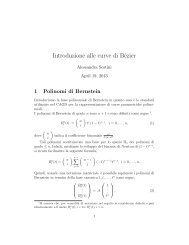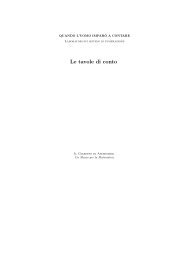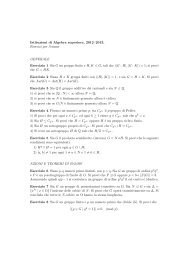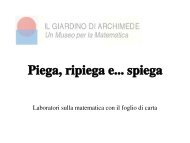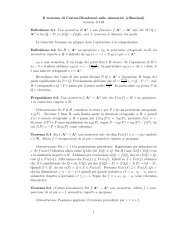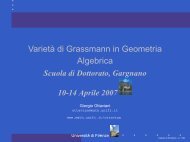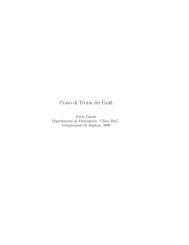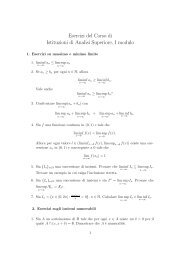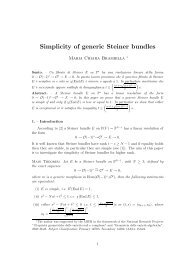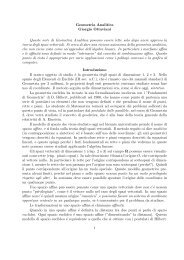Tesi di Laurea di Valentina Boccini - Dipartimento di Matematica e ...
Tesi di Laurea di Valentina Boccini - Dipartimento di Matematica e ...
Tesi di Laurea di Valentina Boccini - Dipartimento di Matematica e ...
Create successful ePaper yourself
Turn your PDF publications into a flip-book with our unique Google optimized e-Paper software.
CAPITOLO 3. COMPLEMENTI AL TEOREMA DI BARNING 78<br />
Si <strong>di</strong>mostra che I 2 = Id3.<br />
Si <strong>di</strong>mostra inoltre che, se (a, b) = 1, allora anche (a ′ , b ′ ) = 1.<br />
Inoltre<br />
c ′ = 3c − 2(a + b) ≥ 3c − 2 √ 2 √ a 2 + b 2 = (3 − 2 √ 2)c > 0.<br />
Quin<strong>di</strong> I porta l’insieme SP P T in se stesso.<br />
I fissa i vettori (1, 0, 1) e (0, 1, 1).<br />
Dimostriamo adesso che I(P P T ) = SP P T \ (P P T ∪ {(1, 0, 1), (0, 1, 1)}).<br />
Questo significa che, se (a, b, c) ∈ P P T, allora almeno uno tra a ′ e b ′ è<br />
negativo, o equivalentemente che 2c < max{a + 2b, 2a + b}.<br />
Per convenzione assumiamo che a > b (il caso a < b si affronta analogamente).<br />
Ci basta <strong>di</strong>mostrare quin<strong>di</strong> che 2c < 2a + b.<br />
dove (x, y) =<br />
2c < 2a + b ⇔ 2 < 2x + y,<br />
<br />
a b , . c c<br />
Con le notazioni precedenti, (x, y) ∈ Q ∩ {x > y}.<br />
2 < 2x + y ⇔ 2<br />
√ <<br />
5 2x<br />
√ +<br />
5 y <br />
2<br />
√ = (x, y), √5 ,<br />
5 1<br />
<br />
√ .<br />
5<br />
Valutiamo il prodotto scalare negli estremi dell’arco Q ∩ {x > y} :<br />
2<br />
√ 5 =<br />
Dato che anche il punto<br />
2<br />
√ 5 <<br />
<br />
(1, 0),<br />
2<br />
√5 , 1<br />
√ 5<br />
<br />
,<br />
<br />
2 1<br />
√ < √2 ,<br />
5 1<br />
<br />
2<br />
√ , √5 ,<br />
2<br />
1<br />
<br />
√ .<br />
5<br />
<br />
(x, y),<br />
<br />
√5 2 , 1<br />
<br />
√<br />
5<br />
2<br />
√5 , 1<br />
√ 5<br />
∈ Q ∩ {x > y}, per continuità:<br />
<br />
, ∀(x, y) ∈ Q ∩ {x > y},<br />
che è proprio quello che volevamo <strong>di</strong>mostrare.<br />
Applicando quin<strong>di</strong> la trasformazione I non troviamo <strong>di</strong>rettamente un’altra<br />
terna pitagorica primitiva, ma possiamo mo<strong>di</strong>ficare ulteriormente la terna<br />
ottenuta in modo che rimanga soluzione dell’equazione. Definiamo:<br />
(a ′′ , b ′′ , c ′′ ) := (|a ′ |, |b ′ |, c ′ ).




